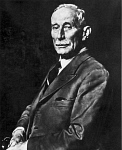Hubert Cecil Booth facts for kids
Quick facts for kids
Hubert Cecil Booth
|
|
|---|---|

Hubert Cecil Booth
|
|
| Born | 4 July 1871 Gloucester, England
|
| Died | 14 January 1955 (aged 83) Croydon, England
|
| Education | City and Guilds Institute, London |
| Spouse(s) |
Charlotte Mary Pearce
(m. 1903; died 1948) |
| Parent(s) |
|
| Engineering career | |
| Discipline | Civil engineer |
| Institutions | Institution of Civil Engineers |
| Significant advance | Invented vacuum cleaner |
Hubert Cecil Booth (born July 4, 1871 – died January 14, 1955) was a clever English engineer. He is most famous for inventing one of the very first powered vacuum cleaners.
Besides vacuum cleaners, he also designed other big things. These included giant Ferris wheels and strong suspension bridges. He even designed factories! Later in his life, he led a company called the British Vacuum Cleaner and Engineering Co.
Contents
Early life and education
Hubert Cecil Booth was born in Gloucester, England, in 1871. He went to school in Gloucester. In 1889, he joined the Central Technical College in London.
He studied civil engineering and mechanical engineering there for three years. He did very well, coming second in his engineering class.
Career and inventions
In 1892, Booth started working as a civil engineer in London. He helped design bridges and huge Ferris wheels. These fun rides were for amusement parks in big cities. Some were in London, Blackpool, Paris, and Vienna. He also helped design engines for Royal Navy battleships.
The first vacuum cleaner
Booth is best known for creating one of the first powered vacuum cleaners. Before his invention, cleaning machines usually blew dirt away. Or they used brushes to sweep it. They didn't suck the dirt up.
In 1901, Booth saw a demonstration of an American cleaning machine. It blew dust off chairs. Booth thought, "What if it could suck the dust instead?" He imagined a filter to catch the dust inside the machine.
To test his idea, he put a handkerchief on a chair. He then put his mouth to the handkerchief and sucked. He saw dust and dirt collected on the cloth! This showed him his idea could work.
Booth then built a very large machine. It was powered by an internal combustion engine. People nicknamed it the "Puffing Billy." This first vacuum cleaner was so big it had to be pulled by horses! It used a pump to suck air through a cloth filter. It didn't have brushes. All the cleaning was done by suction through long tubes.
He later made an electric-powered model. But both designs were still huge. They had to be brought to buildings by horse and carriage. Booth's company was the first to use the term "vacuum cleaner."
Cleaning services
At first, Booth didn't sell his machines. Instead, he sold cleaning services. Bright red vans from his British Vacuum Cleaner Company (BVCC) would arrive. Workers would pull long hoses from the van. They would feed them through windows to clean inside buildings.
Booth sometimes got complaints about the noise of his machines. He was even fined for scaring horses! But his invention soon became very popular.
His motorized vacuum cleaner was used to clean the carpets of Westminster Abbey. This was before King Edward VII's coronation in 1901. The Royal Navy also used his device to keep their barracks clean. Businesses like theaters and shops used them too. However, the machines were too big for homes.
Once, while cleaning the Royal Mint, Booth was arrested. His machine had collected a lot of silver dust from coins. He had forgotten to empty it! But he was quickly released.
Booth received his first patents for the vacuum cleaner in 1901. His company, Goblin, continued to improve the invention. Even though other companies like Hoover became bigger for home vacuums, Booth's company focused on industrial cleaning. They built larger models for factories and warehouses. Today, Booth's company, now called BVC, is part of Quirepace Ltd.
Personal life
In 1903, Hubert Booth married Charlotte Mary Pearce. He was offered a special honor called a Knighthood, but he chose not to accept it. His father, Abraham Booth, helped develop the transatlantic telephone lines. Hubert Cecil Booth passed away on January 14, 1955, in Croydon, England.
Tribute
On July 4, 2018, Google celebrated Hubert Cecil Booth's 147th birthday. They made a special Google Doodle in his honor.
See also
 In Spanish: Hubert Cecil Booth para niños
In Spanish: Hubert Cecil Booth para niños

